
views
Propagating Peperomia in Soil

Fill a 4 in (10 cm) plant pot with well-drained potting soil. Keep pouring in the soil until it sits 1 inch (2.5 cm) below the pot's rim and then moisten the soil with water. Once the pot's soil is moist, make a small hole with your finger—this is where you'll plant the peperomia once it's cut and prepped.
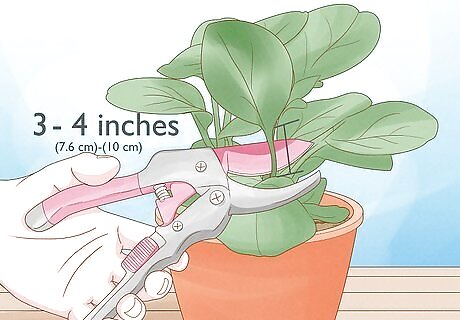
Clip a healthy stem from the parent peperomia plant. Look over the peperomia plant and choose a stem with at least four leaves. Snip the stem off right below its lowest leaf with a hand pruner, making it 3 inches (7.6 cm) to 4 inches (10 cm) long, and then use the pruner again to remove the two bottom leaves on the stem. It's good to take multiple clippings for propagation, but cut away no more than ⅓ of the parent plant overall—otherwise, you'd risk damaging it!
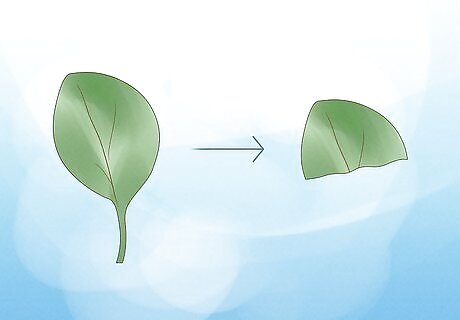
Take an individual leaf from the parent peperomia plant, alternatively. Make your cut right at the base of the leaf, where it meets the stem. You can use the whole leaf, or cut it in half across the width of the leaf using the hand pruners and use both halves to propagate the peperomia. Both cut leaves and whole leaves work for propagation. If you're having trouble getting an entire leaf to stand upright in soil, try cutting it in half and planting it that way. Both methods (stem cuttings or leaf cuttings) will propagate more peperomia, so the choice is entirely up to you! Note that stems will likely produce new growth faster, however.
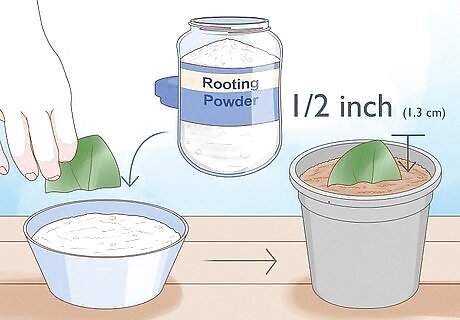
Dip the cutting in rooting powder and plant it in the soil. If you have a stem, place the clipped end (where roots will eventually grow) into rooting powder to accelerate the plant's growth. For a whole leaf, press each cut side into the powder before planting them. Place the cutting ⁄2 inch (1.3 cm) deep into the soil and pat down the soil gently to hold it in place. Make sure you don't leave more than 2 hours between cutting the stems and planting them, or the stems will die.
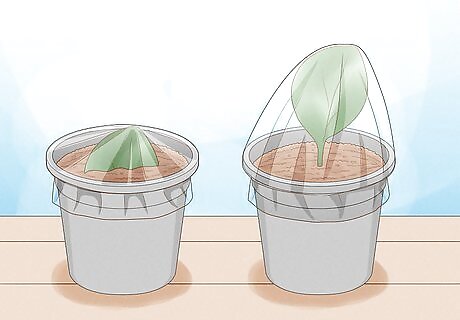
Cover each planted cutting with a clear plastic bag. The bag creates a greenhouse effect, keeping the air around your peperomia cuttings warm and moist. Poke a few holes in the bag to ensure your plants still have fresh air, and prop a chopstick upright in the soil to ensure the bag doesn't droop onto the plant. Alternatively, you could cut an empty large soda bottle in half and use that as the greenhouse instead of a bag. Poke a few holes in the bottle, same as you would with a bag.
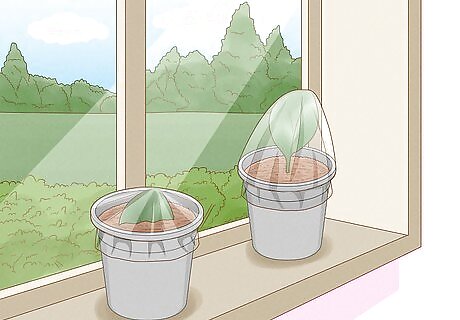
Put the pot in a spot with bright, indirect natural light. Peperomia is sensitive to full sun—when exposed to direct sunlight for an extended time, the plant will likely get burned. Find a room in your home that stays at room temperature consistently without much fluctuation and pick out a spot where the sun lights but doesn't hit directly. This is the ideal location for your peperomia while it propagates. If there's a lot of natural sunlight in your home, check your peperomia for signs of sunburn. When a plant gets burned, you'll be able to spot yellowing or scorch marks on the leaves.
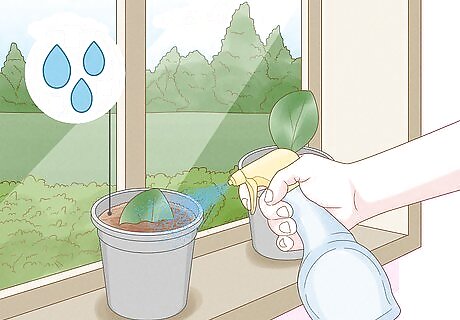
Keep the soil moist and wait 4-6 weeks for the cuttings to grow. It will take at least a month for the cuttings to sprout roots and new leaves. During this time, remove your bag dome for a few minutes every couple of days and water the soil enough to keep it damp. Make sure the soil always stays moist during this waiting period but never gets drenched.
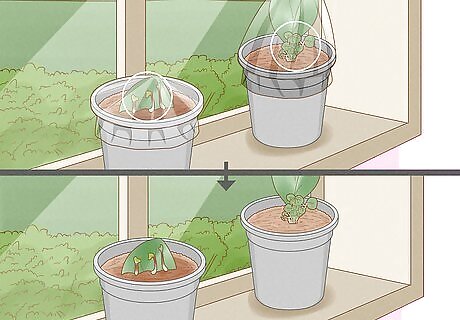
Remove the bag dome once you spot new growth. You don't need the "greenhouse" bag once the cutting has successfully started to grow. However, you don't need to re-pot it right away either—wait until the peperomia has several new leaves and is well-rooted (meaning it doesn't budge if you gently pull on it) so that you can transplant it.
Propagating Peperomia in Water
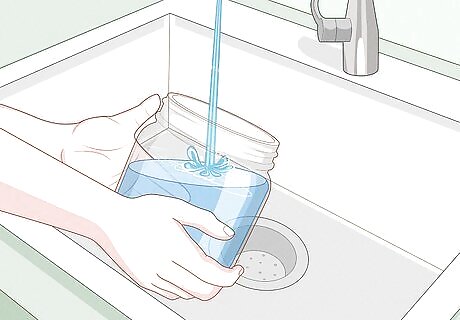
Fill a cup or glass jar with water. This is where you'll leave your peperomia to propagate for several weeks! Alternatively, you could pick up a water propagation station that features little bottles or tubes specifically designed to accommodate plant cuttings. However, any cup or jar lying around your home will work just fine.
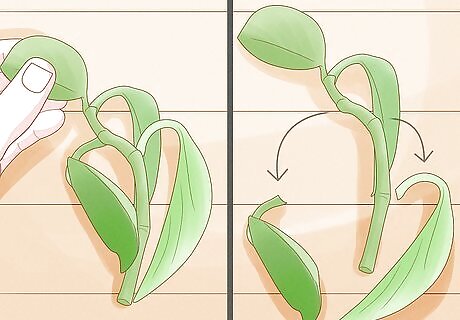
Snip a healthy peperomia stem for propagation. Take off a stem with at least 4 leaves, and remove the 2 lowest leaves with your hand pruners. While individual leaves work well in soil, they're more difficult to maneuver into place for water propagation, so stick to stems exclusively! You can take more than 1 cutting from the plant, especially if you have a water propagation station with multiple vessels, but take no more than ⅓ of the plant.
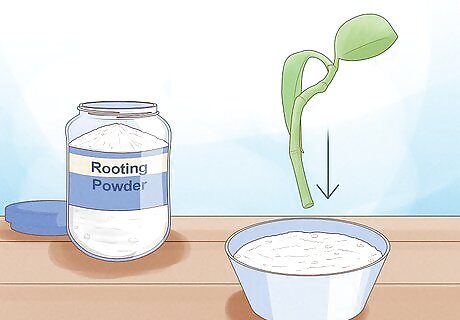
Dip the end of the stem in rooting powder. While plants can successfully propagate without rooting powder, it's still a good idea to use because it accelerates the process. Make sure you fully coat the cut end of the stem in powder to prepare it for propagation.

Place the stem in water and leave them in a brightly-lit space. Peperomia cuttings prefer strong indirect light—they might burn if placed in direct sunlight. Ensure the space is consistently at room temperature to keep the stems comfortable. Refill the water to ensure your peperomia cuttings grow whenever it gets low.
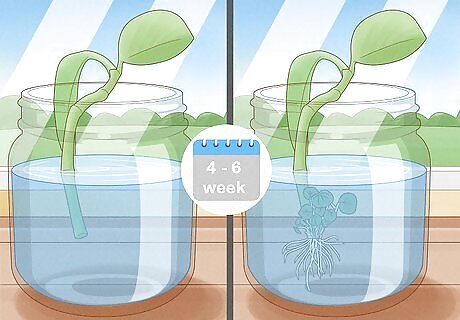
Look for new growth after 4 to 6 weeks. Be patient and monitor your peperomia to see if it propagates. You'll know that your cuttings are successfully growing when you see little roots growing out from the bottom of the stem. You may also see new leaves beginning to sprout from the stem. Once your peperomia cuttings develop, it'll be time to plant them in a proper pot with soil.
Transplanting Newly-Propagated Peperomia

Pour a layer of well-drained potting soil into a larger pot. For young peperomia, any 6 in (15 cm) plant pot with drainage holes in the bottom should work perfectly. Once the new pot is roughly ⅔ of the way full with soil, pat down the layer to remove any air pockets. If you can't get a pot with a drainage hole, try adding a layer of gravel for plant drainage to the bottom of the pot.

Remove the peperomia from its current container and loosen the roots. Turn the pot sideways and tap its bottom, holding your peperomia gently by the stem until the whole plant slides free. Massage the peperomia's roots with your hand, taking care not to dislodge all of the soil. Just loosen the roots—and if there are multiple cuttings per pot, carefully untangle them. If you propagated your peperomia in water, all you'll need to do at this point is remove it from the jar!
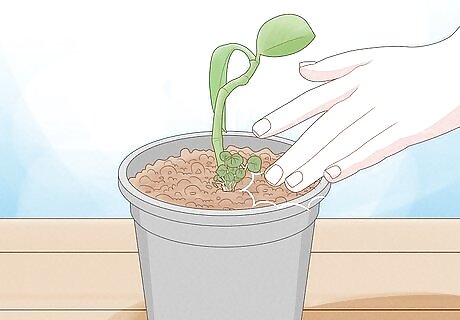
Place your plant into the new pot and fill it with soil. Set the peperomia on top of the soil layer you poured and center it inside the 6 in (15 cm) plant pot. Then, pour in more potting soil around the sides of the plant until it is secure and stands upright without your help. Even out the potting soil on top so that it lays relatively flat, and make sure it covers the top of the peperomia roots.
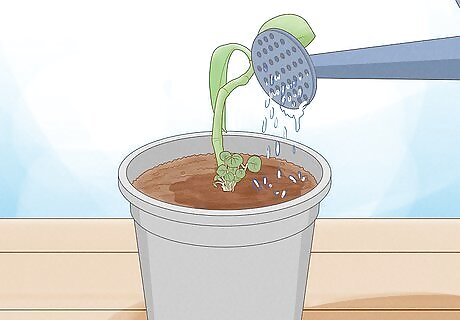
Water the peperomia to help the potting soil settle into place. Give your plants enough water to make all the soil in the pot damp. Since you've just re-potted the peperomia, the new soil hasn't had a chance to sink in between all the roots; watering your new plants will move the soil into place and set it firmly around the roots. You don't need to add any fertilizer here—just give it some water and watch it grow! Give your peperomia some extra water for the first few weeks after re-potting. The plant's roots will need extra moisture as they acclimate and grow.
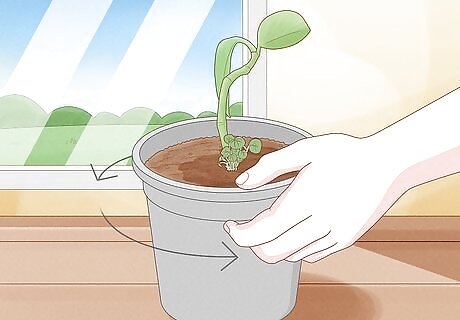
Keep the peperomia in a warm spot with indirect sunlight. Like the cuttings, peperomia plants do best at room temperature in a shady place where they're shielded from direct sunlight. They also need to be watered regularly to maintain the moisture in the soil, so check on your peperomia every couple of days and water them if the soil looks dry.


















Comments
0 comment